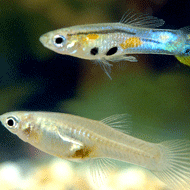
Study sheds light on colour differences in males and females
Gene behaviour could explain why striking traits, such as bright colours, are only seen in the males of certain species.
Researchers from the Universities of Edinburgh and Exeter studied the genetics of Trinidadian guppy fish, whose males are brightly coloured - unlike the dull brown of the females.
The team compared genetic maps of several generations, alongside entire genetic codes. They discovered that in male guppy reproduction, packages of genes in chromosomes only exchange genes from their tips.
This differs from typical sexual reproduction, where a set of genes from each parent combines randomly to create offspring with a mix of features from both parents.
In male guppies, many genes - including those that create bright colours - are passed from one male generation to the next, rarely mixing with genes inherited by females. It is thought this low rate of genetic mixing between sexes has allowed the male’s brightly coloured appearance to evolve, conserving the characteristic.
Dr Lengxob Yon, from the Centre for Ecology and Conservation, University of Exeter, said: “One of the remarkable things about the results is that not only are male and females different morphologically, but differences can be observed at a genetic level, specifically in the way that genetic information is exchanged via crossing over within each sex.”
“And such sex differences in recombination rates can have important consequences on how males and females appear, and partly explain how sexual dimorphism evolves.”
Image © Amy E. Deacon, Hideyasu Shimadzu, Maria Dornelas, Indar W. Ramnarine & Anne E. Magurran (Wikimedia Commons/CC BY 4.0)



 The Animal and Plant Health Agency (APHA) has updated its online reporting service for dead wild birds.
The Animal and Plant Health Agency (APHA) has updated its online reporting service for dead wild birds.